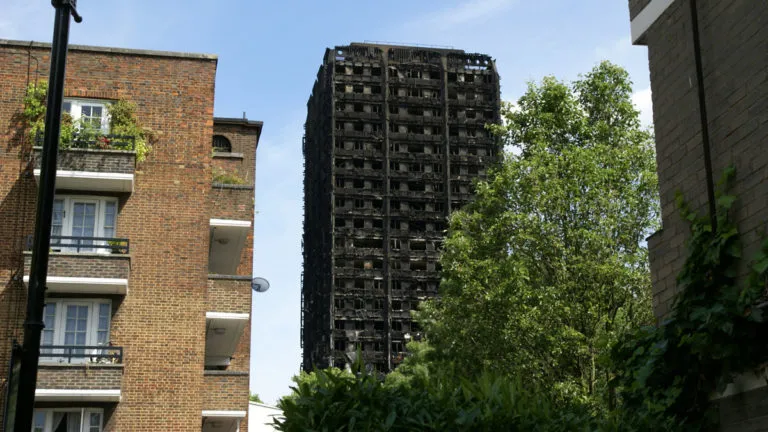Government is leading by spending on cladding and banning combustibles
Published: by John Bibby

It has been a momentous week for everyone campaigning for improvements to building safety, following the Grenfell Tower fire.
By promising to ‘fully fund’ the removal and replacement of unsafe, Grenfell-style cladding – and suggesting it’s minded to ban combustible cladding systems – the government is set to fulfil two of our key campaigning asks. We look back at what exactly the government has committed to and why it’s so important.
Money to remove and replace cladding
Our campaign asked for: emergency funding to be provided for social landlords struggling to afford to replace cladding.
On Wednesday, the government announced it will ‘fully fund’ removing unsafe, Grenfell-style cladding from all council and housing association tower blocks.
By the end of July last year, more than 150 council and housing association tower blocks had been found to be wrapped in materials similar to those that appear to have contributed to the tragedy at Grenfell. And in the 10 months since, an increasing number of privately owned blocks have been added to the list as well. In total, Grenfell-style cladding has been identified on more than 300 tower blocks across the country.
But if finding the buildings happened quickly (for social blocks, at least), progress on removing and replacing the cladding systems has been painfully slow – leaving many tenants anxious and leaseholders racking up huge bills in additional safety measures. The government statistics show that nearly 10 months on from when they were identified, only seven of the 158 social tower blocks have had their cladding entirely replaced.
Money has been one of the key barriers to speeding up the process. Before the announcement of national funding, hard-pressed councils and housing associations have been trying to rejig overstretched budgets to find the cash. Some that we have spoken to have been facing tough choices about other things they might have to cut back on, like refurbishing homes or building new social housing.
The announcement of national funding should mean this barrier is removed. What’s more, the nature of the government’s commitment to meeting the costs of the work is particularly strong. It has estimated the cost at £400 million. To put this into some kind of context, by our reckoning it will be the largest national spending on existing social housing since other than housing benefit since the end of the Decent Homes Programme.
But importantly it hasn’t yet set an artificial limit on how much it is prepared to spend.
From conversations with social landlords, we know that the estimated costs of replacing dangerous cladding can spiral. In one case, we heard an initial estimate of £2 million rose to a final cost of £18 million. National government oversight should help to keep costs down – for example, through more national coordination and even bulk procurement. But by pledging to fully fund the replacement of unsafe cladding, the government appears to be giving itself the room to meet costs even if they rise.
Combustibles likely to be banned
We asked for: clearer guidance on which cladding is and isn’t safe.
Another key barrier to speeding up the replacement of cladding has been uncertainty about what should be put up once it’s removed. Many in the industry had been waiting for the publication of the independent Hackitt Review of building regulations, in the hope that it would be explicit about what cladding systems are and aren’t safe to use. While it’s clear that their existing cladding is too combustible to be safe, there has been uncertainty about whether less combustible, but not entirely non-combustible, cladding would be allowed in future.
Some landlords were worried that they could end up replacing the unsafe cladding, only to be told by the review that the replacement cladding was also unsafe. In the event, the review ducked out of making a clear decision, and was subject to a significant backlash.
However, within hours of the review’s publication, the Secretary of State James Brokenshire has said he is minded to make the regulations as clear as they can possibly be by banning combustible cladding altogether. By implication, this should also mean we no longer need to worry about the issue of ‘desktop studies’. We’ve written before about concerns that desktop studies are a less rigorous way of testing new combustible cladding and insulation systems. But if combustible cladding and insulation systems were banned entirely, it should become a non-issue.
What happens next?
There are obviously still unresolved issues. In particular, we need to see actual urgent progress on removal and replacement, many leaseholders in private blocks are still worried about getting stung with huge bills, and we still need to see much more detail on the government’s announcements. But perhaps as important as the announcements that have been made this week is what they say about the government’s approach. For months, we have been waiting for the announcement of money, clarity and urgency.
The government’s decisions this week indicate that now the Hackitt Review has finished, it feels it can do what governments are supposed to do – lead.